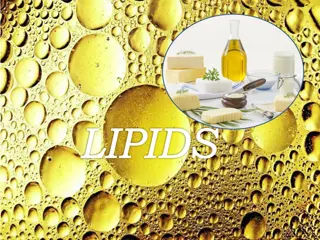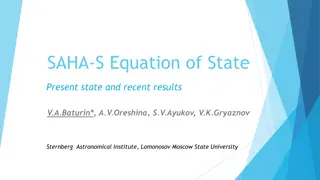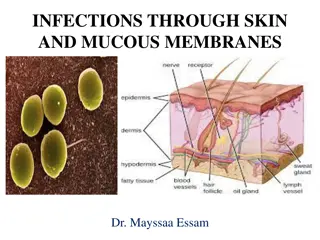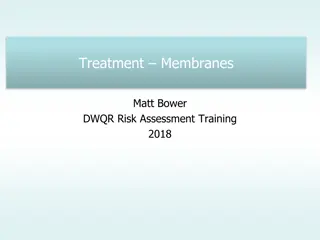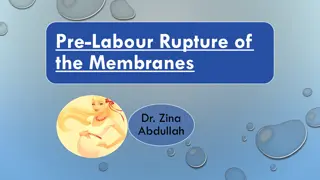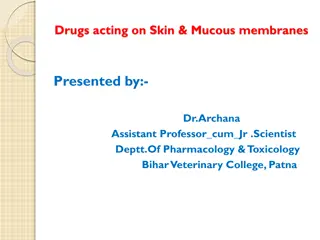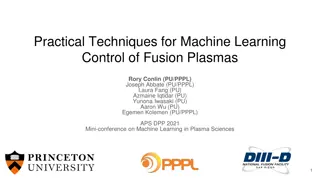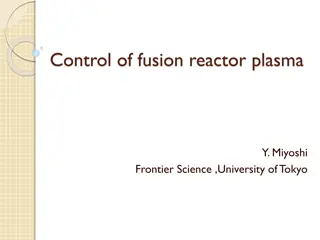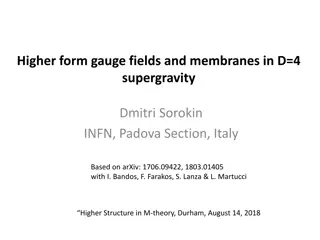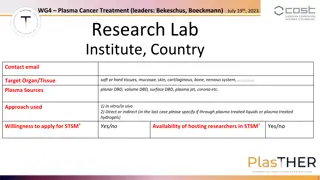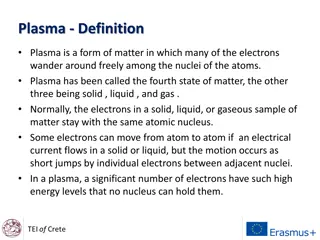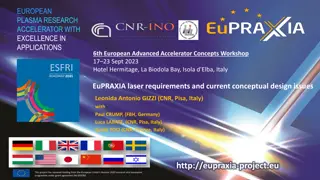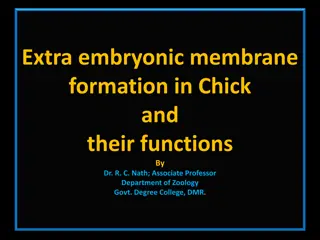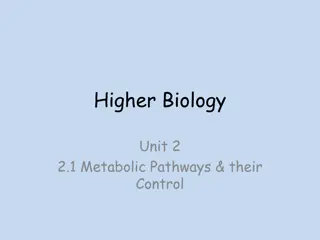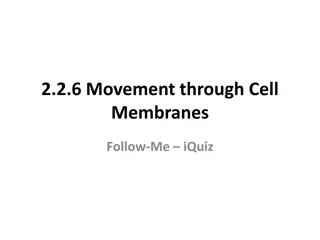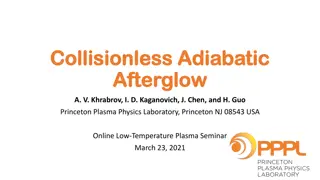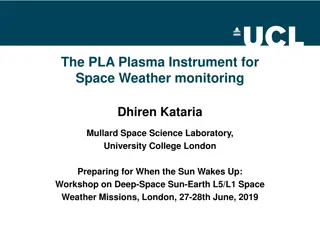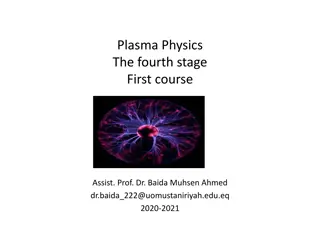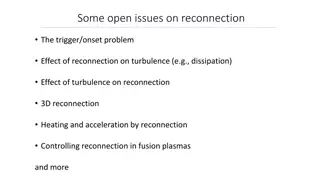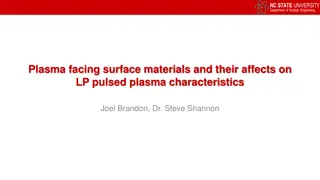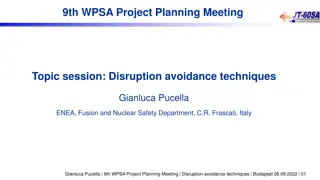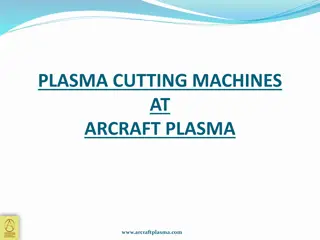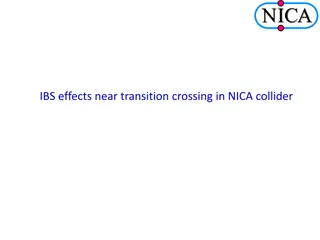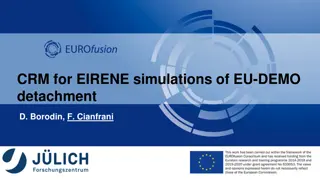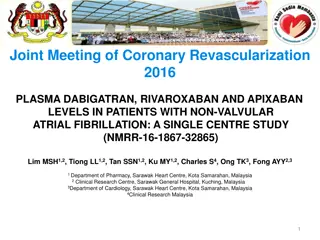Understanding Plasma Physics: Single Particle Motion in Magnetic Fields
Delve into the intricate dynamics of single particle motion in plasma physics, focusing on the crucial role of magnetic fields for plasma confinement in fusion environments. Explore concepts such as magnetic mirrors, E.B. drift, and Tokamaks, essential for comprehending the behavior of ions and elec
2 views • 34 slides
Understanding Plasma Proteins and Their Functions
Plasma proteins play a crucial role in various physiological functions such as controlling extracellular fluid distribution and transportation of hormones, vitamins, and other substances. The balance between protein synthesis and catabolism determines protein levels in the vascular compartment, affe
6 views • 23 slides
Understanding Lipids: Properties, Functions, and Types
Lipids are a diverse group of organic compounds that include fats, oils, hormones, and components of cell membranes. They are vital for energy storage, structural roles in cell membranes, hormone synthesis, and organ protection. Lipids can be classified into different types such as waxes, triglyceri
11 views • 14 slides
Thermodynamics of Solar Plasma: SAHA-S Equation of State and Recent Results
SAHA-S equation of state (EOS) presents the current state and recent results in thermodynamics of solar plasma. Key authors V.K. Gryaznov, A.N. Starostin, and others have contributed to this field over 20 years. The equilibrium composition between 145 species, including elements and all ions, is exp
1 views • 23 slides
Understanding Infections through Skin and Mucous Membranes
Infections can be transmitted through skin and mucous membranes via direct or indirect human contact, as well as from non-human sources. The infective agents include viruses, bacteria, fungi, and arthropods. Factors like high population density, poor hygiene, and host behavior play crucial roles in
4 views • 26 slides
Comprehensive Overview of Treatment Membranes in Water Quality Risk Assessment Training
Comprehensive overview of treatment membranes in water quality risk assessment training, covering various membrane types, applications, and considerations. Membranes play a crucial role in removing a range of contaminants from water sources, with different membrane types suited for specific applicat
0 views • 9 slides
Mechanism of General Anaesthesia Theories: Lipid Solubility, Surface Tension, Microcrystal, Protein Binding
Mechanism of general anaesthesia involves theories focusing on the interaction of anaesthetics with cell membrane components like lipids and proteins. The Lipid Solubility theory emphasizes the importance of an anaesthetic's affinity and solubility in nerve cell membranes, while the Surface Tension
1 views • 10 slides
Understanding Plasma Proteins in Biochemistry Lectures
This informative content discusses the types, functions, and measurement of plasma proteins in biochemistry. It covers the importance of identifying various plasma proteins, their roles in disease diagnosis, and the interpretation of electrophoretic patterns. The lecture overview provides insights i
0 views • 30 slides
Clinical Diagnosis and Assessment of Pre-Labour Rupture of the Membranes
Pre-Labour Rupture of the Membranes (RROM) is characterized by the leakage of amniotic fluid before the onset of labor, particularly when the gestational age is less than 37 weeks. Clinical diagnosis involves a thorough history evaluation and examination, including sterile speculum examination to co
0 views • 18 slides
Overview of Drugs Acting on Skin & Mucous Membranes
This presentation discusses different classes of drugs that act on the skin and mucous membranes, including emollients, demulcents, adsorbents, protectives, astringents, counterirritants, keratolytics, and skin disinfectants. Emollients soften and moisturize the skin, demulcents soothe irritation in
3 views • 10 slides
Understanding Bacterial Cell Structure and Function
Bacteria display unique cellular structures and functions that differ from eukaryotic cells. They have a simple structure with a plasma membrane but lack complex internal membrane systems. The cytoplasm contains inclusion bodies, ribosomes, and genetic material in the nucleoid. Bacteria can be categ
4 views • 21 slides
Mechanism of Low-Energy Nuclear Reactions in Low-Temperature Plasma
This work discusses nuclear-chemical processes underlying low-energy nuclear reactions in low-temperature plasma environments, focusing on the initiation of artificial radioactivity in metal cathodes under protium- and deuterium-containing nonequilibrium plasma conditions. The role of electrons with
4 views • 6 slides
Development of Plasma-Facing Geometry Design for W-Divertor in SOLTKT Fusion Reactor
Study on the plasma-facing geometry design based on power shell geometry in the SOL TKT W-divertor development for the fusion reactor. The research involves fundamental differences in divertor baffle design, materials used, heat load requirements, interface connections, and key design concerns. The
0 views • 14 slides
Practical Machine Learning Techniques for Fusion Plasma Control
This presentation discusses the use of machine learning for controlling fusion plasma states, covering topics such as control-oriented modeling, neural networks for plasma dynamics, linearization techniques, and applying linear control laws in latent states for efficient control. The focus is on lev
0 views • 15 slides
Utilizing a Global Model for Analyzing Reaction Pathways in Plasma Systems
This research focuses on using a kinetic global model framework to identify relevant reactions in chemically complex plasma systems. The framework, KGMf, enables the investigation of macroscopic plasma characteristics by analyzing reaction pathways, sensitivity to reaction rate errors, and dominant
1 views • 6 slides
Advances in Fusion Reactor Plasma Control at University of Tokyo
Explore the cutting-edge research on control systems for fusion reactor plasma at the Frontier Science department, University of Tokyo. The study focuses on developing construction and logic control parameters for high-performance plasma, showcasing categorizations of control parameters and actuator
0 views • 25 slides
Advanced Plasma Control Systems in Fusion Experiments
The construction of control systems for high-performance plasma with limited actuators or diagnostics is crucial for ongoing fusion experiments like ITER and DEMO. This involves developing control logic, categorizing various parameters, and understanding actuator systems. Multiple control experiment
2 views • 25 slides
Advancing Plasma Medicine: Research Contributions and Networking Opportunities
Explore the latest in plasma medicine research at the II Annual Meeting. Share your results, network with peers, and contribute to the field through collaborative discussions. Answer key questions, meet deliverables, and pave the way for advancements in plasma therapies and biomedical applications.
0 views • 9 slides
Higher-Form Gauge Fields and Membranes in D=4 Supergravity
This study focuses on higher-form gauge fields and membranes in D=4 supergravity, exploring their role in cosmological constant generation and membrane nucleation. The dynamics of three-form gauge fields, their coupling to gravity and membranes, and implications for cosmological models and supersymm
0 views • 17 slides
Advancements in Plasma Cancer Treatment: Research Focus and Collaboration Efforts
Explore the cutting-edge research on plasma-based cancer treatment led by Bekeschus and Boeckmann at the Research Lab Institute. The team specializes in addressing cancer in various tissues such as skin, bone, cartilaginous, and nervous systems. Discover their innovative approaches, infrastructure,
0 views • 4 slides
Understanding Plasma - The Fourth State of Matter
Plasma, the fourth state of matter, is a unique form where electrons freely move among atomic nuclei. It is created when atoms are ionized and can conduct electricity. This article delves into how plasma is produced, its applications like plasma display panels, and the construction of a plasma displ
0 views • 37 slides
European Plasma Research Accelerator with Excellence in Applications
The European Plasma Research Accelerator project, also known as EuPRAXIA, is a cutting-edge initiative that aims to develop a laser driver for advanced accelerator concepts. Led by a team of experts from various European countries, the project focuses on laser requirements, overall layout, thermal m
0 views • 33 slides
Understanding Membrane Transport Processes in Plant Cells
Plant cells are separated from the environment by plasma membranes, which facilitate the movement of molecules through passive and active transport mechanisms. Transport proteins play a crucial role in allowing the movement of ions and polar molecules, with channels, carriers, and pumps enhancing so
0 views • 20 slides
Extra Embryonic Membrane Formation in Chick and Their Functions
The development of extra embryonic membranes in chick embryos plays a crucial role in their growth and protection. These membranes, including the amnion and chorion, serve various functions such as providing protection, facilitating gas exchange, and supporting the formation of the placenta. Underst
0 views • 20 slides
Plasma Etching Challenges and Solutions in Semiconductor Fabrication
Understanding the importance of plasma etching in semiconductor fabrication, this discourse delves into the challenges faced in modeling modern etch processes. Topics covered include stochastic defect detection, reactor-level plasma physics, and an integrated model hierarchy approach. Techniques suc
0 views • 14 slides
Understanding the Structure and Function of Cell Membranes in Biology
Explore the intricate details of cell membranes, focusing on the phospholipid bilayer structure, protein interactions, selective permeability, and various transport mechanisms. Discover how membranes regulate the entry and exit of substances, aid in metabolism, and compartmentalize organelles for ef
0 views • 20 slides
Understanding Osmosis in Cell Membranes
This quiz explores the concept of osmosis in cell membranes, focusing on the movement of water into outermost cells of roots by osmosis and its implications on cell sap. It covers topics such as active transport, diffusion, pressure in cell contents, and the role of water movement in maintaining the
0 views • 50 slides
Advancements in Plasma Medicine: Research Contributions and Collaboration Opportunities
Explore how research in plasma medicine contributes to the field, focusing on bioactive components, molecular interactions, standard protocols, and potential biomedical applications. Emphasize the importance of sharing results, fostering collaborations, and addressing critical points for further inv
0 views • 9 slides
Understanding Biomembranes: Composition, Structure, and Functions
Biomembranes, specifically the plasma membrane, play a crucial role in cell function by separating and protecting the cell, facilitating communication with the environment, and regulating transport processes. Composed of lipids, proteins, and carbohydrates, membranes have a fluid mosaic structure wi
0 views • 13 slides
Evolution of Collisionless Plasma Bounded by Absorbing Walls
Study on the evolution of collisionless plasma between absorbing walls, analyzing rarefaction waves, density profiles, and plasma potential decay. Kinetic simulations reveal gas dynamics-like behavior with flat density profiles and linear velocity profiles leading to asymptotic decay. The influence
0 views • 15 slides
Advancements in Plasma Instruments for Space Weather Monitoring
Explore the latest developments in plasma instruments for space weather monitoring, including the PLA Plasma Instrument and MSSL Heritage in Plasma Instruments. These instruments enable precise measurement of plasma parameters in deep space, supporting missions to study solar wind, ion densities, an
0 views • 22 slides
Understanding Plasma Physics: The Fourth Stage First Course by Prof. Dr. Baida Muhsen Ahmed
Plasma, the fourth state of matter, was introduced by Langmuir in 1928. It is a unique form of matter containing ions and exhibits collective behavior. This course explores the relationship between solid, liquid, gas, and plasma, discussing forces, parameters, and where plasmas are found in the cosm
0 views • 11 slides
Recent Developments in Plasma Reconnection Experiments
Explore key open issues in plasma reconnection such as trigger/onset problems, turbulence effects, 3D reconnection, and the impact on heating and acceleration. Discover new experimental developments like the Big Red Ball at Wisconsin for field-free plasma confinement and access to different reconnec
0 views • 8 slides
Study on Plasma Facing Surface Materials in Nuclear Engineering at NC State University
This research at NC State University's Department of Nuclear Engineering focuses on the effects of plasma facing surface materials on low-pressure pulsed plasma characteristics. The study delves into topics such as electron sources, secondary emission, dissociative recombination, modeling results, c
0 views • 31 slides
Utilizing Disruption Avoidance Techniques in Plasma Control for Enhanced Stability
Exploring disruption avoidance techniques in plasma control is crucial for maintaining stability and safety in operating scenarios. Gianluca Pucella discusses topics such as plasma disruptions, prevention methods, emergency shutdown protocols, and disruption prediction models involving machine learn
0 views • 7 slides
Advanced Plasma Cutting Machines at Arcraft Plasma
Arcraft Plasma offers high-quality plasma cutting machines capable of cutting ferrous and non-ferrous materials up to 150mm thickness. These machines come in 12 models with beveling and hole piercing options. The plasma cutting process involves the use of air or inert gas to create plasma that melts
0 views • 12 slides
Insights into Intra-Beam Scattering Effects and Plasma Dynamics in Particle Colliders
Intra-Beam Scattering (IBS) effects near transition crossing in NICA collider result in energy exchange between different degrees of freedom, impacting beam size, luminosity, and lifetime. The IBS phenomenon is crucial for circular machines, with theoretical developments by Piwinski and Bjorken shap
0 views • 15 slides
Understanding Collisional-Radiative Models for Plasma Detachment Control in Tokamaks
Explore the application of Collisional-Radiative Models (CRM) in EIRENE simulations for plasma detachment control in tokamaks. Learn about detached plasma divertor, main reactions in transport, vibrational states in molecular species, and more through a detailed study of particle species, reaction t
0 views • 10 slides
Plasma Levels of NOACs in Patients with NVAF: Single Centre Study
This study aims to characterize the plasma levels of Dabigatran, Rivaroxaban, and Apixaban in patients with non-valvular atrial fibrillation (NVAF) who have been taking these drugs for more than 4 days. The research also assesses median trough plasma levels of these anticoagulants, as well as their
0 views • 18 slides
Understanding the Composition and Function of the Plasma Membrane in Animal Cells
The plasma membrane is a vital component of animal cells, serving as a barrier that regulates the passage of substances. Composed mainly of lipids and proteins, it plays a crucial role in cell structure and function. This article explores the chemical composition, molecular structure, and significan
0 views • 16 slides


